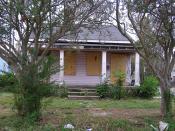Education in Argentina What is the connection between Argentina and Memphis? The past decade has seen a tremendous increase in the Hispanic population within the Memphis metropolitan area. According to the 2000 census survey, 27,520 Hispanics reside in Memphis and many of these people work in the continually growing distribution sector (Levie, 2001). "With continued Latino immigration to the Memphis area, many changes and developments are being made in the workplace"æ" (Levie, 2001).
Along with the changes to employment, adjustments in education must be made in order to reduce the barriers to the Hispanic community, which include understanding a foreign culture and overcoming the obstacle of language.
Do children in Argentina go mainly to public or private schools? Education in Argentina is mainly conducted within the public realm, while private sector schools do exist, the poor economy within the various provinces of Argentina do not afford for private schooling of most children.
Do Argentine schools have the same grade structure as ours? The educational structure in Argentina is set up differently than the structure of the United States. Compulsory and mandatory schooling in Argentina is set up in three cycles, which end at the age of fourteen. Once a child turns fourteen, she must decide which orientation of the Polymodal education she will study. (Gonzales, 2001).
If a child from Argentina went to an American school, what things about it would she or he find surprising? The most distinguishing difference an Argentine child attending an American school would find is that bilingual education does not begin immediately and that for some it is voluntary.
If an American child went to an Argentine school, what things would strike the American child as unusual or strange? One area that an American child might find unusual is that the Argentine government requires that parents "supervise and support their children's education; and the respect and make their children respect the norms of solidarity within the education unit" (Dupre, 2001). Of course, this intense parental participation might not be as prevalent in more rural areas where poverty forces some children into the work force as early as age 12 (Dupre, 2001 ) What does an Argentine classroom and school look like? "Schools in Argentina are not properly kept because our government is busy paying our foreign debt" (Gonzales, 2001). In the poor areas, schools are a low priority because people don't have enough money to live much less contribute to the schools. In good neighborhoods, conditions are better since "parents help support them" (Gonzales, 2001).
Who sets the curriculum for Argentine schools? Is it the same as the curriculum taught in American schools? Argentina has a national curriculum of Initial Education, Basic General Education and Polymodal Education, which is laid out in the Argentine Constitution (Dupre, 2001). Curriculum is a bit different from that of American schools. Whereas schools in the U.S. are set up by "grades," in Argentina, there are three levels of education.
Each student chooses which polymodal system he or she will follow in the university. The systems are as follows: Humanities and Social Sciences, Natural sciences, Production of Goods and Services, Economy and Management and Communication, Art and Design (Tandilnet).
Are teachers in Argentina certified? Yes and no. There is a three-year career call Magisterio whereby an upcoming teacher begins working as a teacher while studying for certification (Gonzalez, 2001). Teacher training takes place at the secondary level and certification is not necessarily required but evaluation of some form is used (International Encyclopedia of National Systems of Education, 1995).
Do teachers in Argentina interact with students the same way they do here? "You cannot avoid that" (Gonzales, 2001). Teachers do not act as social workers but they do provide assistance. Some schools have a Gabinete psicologico where a special group of people trained to deal with special problems help the student, the teacher and the parents (Gonzales, 2001).
How is student discipline dealt with in Argentina? Discipline in Argentina focus' on many of the same issues we have in the United States. Issues of gang activity, drug use and violence are of primary concern (Dupre, 2001).
References Argentina. International Encyclopedia of National Systems of Education. 2nd Ed., 1995. Pp 32-39. Post Lethwaite Publishing Dupre, Ann. (2001, January). Transforming Education: The Lesson from Argentina Vanderbilt Journal of Transnational Law. (Volume 43, number 1). Retrieved September 8, 2001 from the world wide web: http://law.vanderbilt.edu/-journal/vol341/dupre.html Education. (n.d.). Retrieved September 15, 2001 from the world wide web: http://www.tandilnet.com/Turismo/education.html Gonzalez, R. Personal Interview, September 9, 2001 Levie, M. (2001, September 11). The Daily Helmsman. Research team hopes to understand immigrant' adaptation to the South. pp. 1,8.





